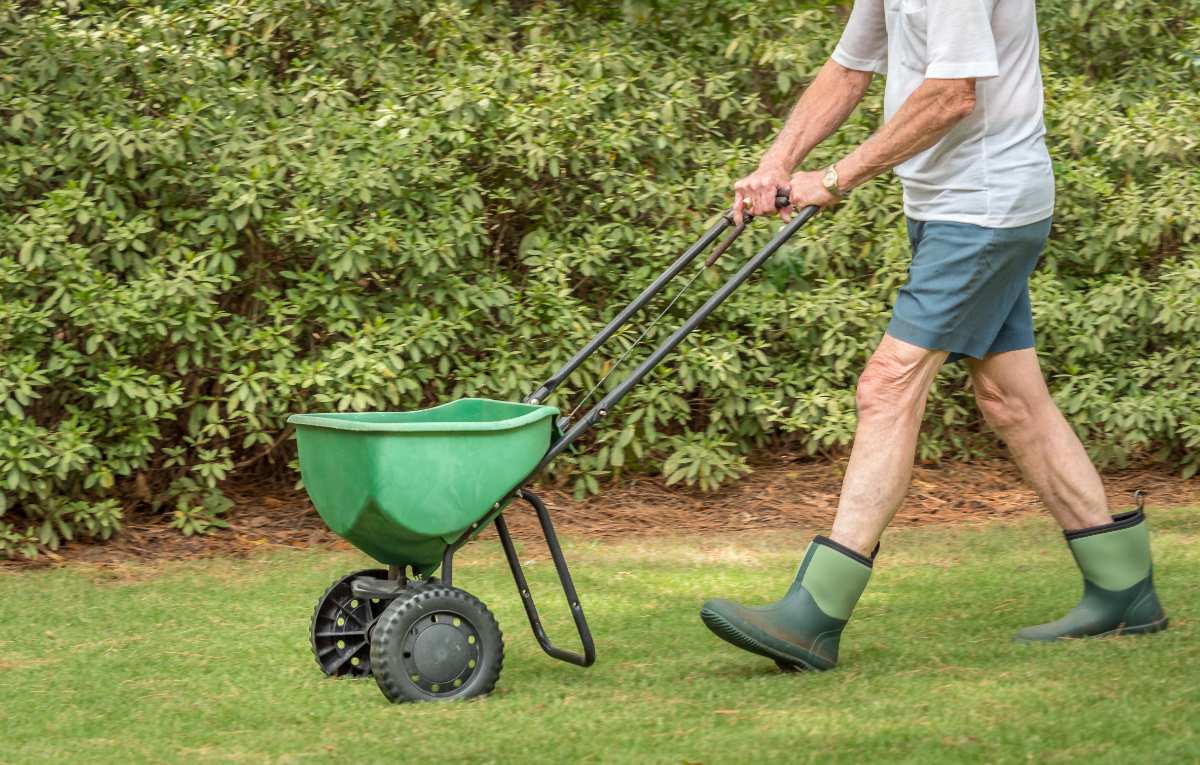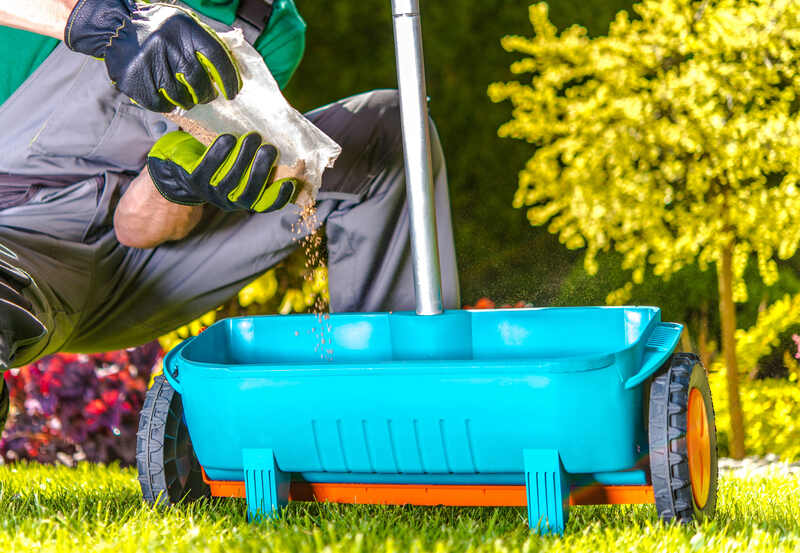
Fall fertilizers determine how your lawn handles the winter stress and bounces back in the spring. They can boost or ruin your grass’s health, so plan the application carefully.
The best time to apply fall fertilizer is usually September through November, but here’s the thing — it depends on your grass type and location. Get the timing right with this rule: Fertilize when soil temperatures reach 50 F to 65 F for cool-season grasses. For warm-season varieties aim for 65 F to 75 F.
Fall Fertilization Depends on Grass Type and Climate
Should you fertilize in the fall? That’s a strong YES for cool-season grasses. These species are actively growing in the fall and need a nitrogen boost around Labor Day and, in some cases, a second application in October or November.
Warm-season varieties, on the other hand, slow their growth in the fall. For warm-season grasses, fall fertilization is optional and should happen as early as possible to ensure the turf can still absorb nutrients and avoid delaying their winter dormancy.
For both grass types, the best time to apply fall fertilizer changes as you move from north to south across the country.

| Hire a LawnStarter pro to fertilize at the right time. Our pros charge an average of $103 per lawn treatment with a 4.4-star rating from 39,500+ jobs done last year. |
See Related:
Cool-Season Grasses in Northern Regions
Fall is cool-season grasses’ second growing season, so fescues, Kentucky bluegrass, and ryegrass benefit the most from fall fertilizers, enjoying:
- Thicker, healthier grass
- Increased winter hardiness
- Prolonged green color
- Faster spring green-up with stronger roots
Because of milder summers and harsher winters, northern regions start and finish fall lawn care earlier. Check the chart below for timing and cues to help you figure out when to fertilize in the fall in your area:
| Early Fall Application (Essential) | Late Fall Application (Optional) | |
| Months | Mid-August to early September | Mid-September to late October |
| Soil temperature | Under 65 F | Over 50 F |
| Frost cue | 6 to 8 weeks before the first frost | 2 to 3 weeks before ground freeze |
| Grass appearance | Grass turns green if it turns brown in the summer | Grass is still green |
In some of our coldest states (North Dakota, Maine), fall fertilizing usually starts in August, when summer temps drop, and wraps up by mid-September.
Moving south, the season shifts later. In states like Kansas and Missouri, the fall fertilization window is early September to early November.
Use a high nitrogen fall fertilizer with slow-release nitrogen, potassium and phosphorus — it supports fall growth and winter hardening. For late fall select a fertilizer with quick-release nitrogen.
Don’t apply fall grass fertilizer on frozen ground. Plants can’t absorb it, and it will run off with the snowmelt, polluting the groundwater.
Pro Tip: Labor Day is a perfect time for early fall fertilization in the northern regions. Take advantage of the long weekend and feed your lawn.
See Related:
Transition Zone in the Middle of the Country
The middle of the U.S. (called the transition zone) grows both warm-season and cool-season grasses, so fall fertilizing schedules vary.
Cool-Season Grasses

Summers are hotter and longer than up north, so there’s more risk of fertilizing cool-season grasses too early. Follow the cues in this chart to get the timing right.
| Early Fall Application (Essential) | Late Fall Application (Optional) | |
| Months | Late August to mid-September | Mid-October to mid-November |
| Soil temperature | Under 65 F | Over 50 F |
| Frost cue | 6-8 weeks before first frost | 2 to 3 weeks before ground freeze |
| Grass appearance | Grass turns green if it is brown in the summer | Grass is still green |
Wait until daytime temps stay below 80 F for a week before fertilizing. Go too early and you risk fertilizer burn and runoff — the grass is still dormant from summer, so it can’t absorb nutrients fast enough.
Some states restrict fertilizer use in late fall. Check local rules before buying fall fertilizer for your grass. For example, Maryland bans phosphorus fertilizers year-round and prohibits nitrogen from Nov. 15 to March 1 to protect the Chesapeake Bay.
See Related: Cities Limiting Use of Lawn Fertilizers and Pesticides
Warm-Season Grasses

Warm-season grasses (Bermuda, Zoysia, centipede, St. Augustine, and bahia) thrive from late spring to late summer and go dormant in the winter, which comes early in the transition zone.
If you need to feed your lawn with a fall fertilizer, the best time is mid-August through September.
| Months | Mid-August through September |
| Soil temperature | 65 F to 75 F |
| Frost | 6-8 weeks before first frost |
| Grass appearance | Still green, not dormant |
Avoid fertilizing with nitrogen later than August, as this can delay dormancy and increase the grass’s susceptibility to winter damage. The best time to fertilize warm-season grasses with nitrogen is late spring to early summer — the beginning of their growing season.
Note: If you need to fertilize with nitrogen in the fall, Texas A&M University recommends using a fertilizer with quick-release nitrogen.
In September, you can apply a potassium-only fertilizer that helps the grass better withstand the cold. Use phosphorus only if the lawn is deficient and the local rules allow it.
Warm-Season Grasses in the Southern U.S.

The further south you live, the longer warm-season grasses keep growing. Fall fertilizing is still debatable — if you fed your lawn enough in spring and summer, skip it. But if your lawn needs it, you have a bigger window to apply it.
| Months | September through October |
| Soil temperature | 65 F to 75 F |
| Frost cue | 6-8 weeks before first frost |
| Grass appearance | Green grass |
Fall fertilizing might be necessary when:
- You maintain a high-end lawn (short, dense, golf-course quality)
- You live in Florida (summer fertilizer ban) and grow hungry grasses like Bermuda or St. Augustine
- Your lawn lacks potassium (needed for winter hardiness)
If you need to apply nitrogen, follow University of Arizona guidelines: no more than 0.25 to 0.50 pound per 1,000 square feet. Otherwise, stick to potassium-only fertilizer.
See Related:
- How and When to Fertilize Bermudagrass Lawns
- How and When to Fertilize Centipedegrass
- How and When to Fertilize Zoysiagrass
- When to Fertilize Bahiagrass in Florida
FAQ
Yes. If you’re overseeding in the fall, either spread a starter fertilizer after seeding or wait until the new grass sprouts and then fertilize the entire area.
You know your grass needs fertilizer if you notice slow growth, yellowish, fading grass color, an increase in weeds and pests, or thinning patches.
It depends on your grass type and timing.
• Cool-season grasses, early fall: Yes — in both cases, the grass needs a balanced, slow-release fertilizer high in nitrogen.
• Cool-season grasses, late fall: No — you need quick-release nitrogen in smaller amounts with more potassium and phosphorus.
• Warm-season grasses: No — spring needs balanced fertilizer, fall needs potassium and phosphorus with little to no nitrogen.
Let the Pros Handle Fall Fertilizing
Fall fertilizing is essential for cool-season grass but tricky for warm-season varieties — one wrong move and you could damage your lawn. Find a LawnStarter fertilizer pro in your area to get the timing and formula exactly right for thick, healthy growth.
Sources:
- “Benefits of Late Fall Fertilization.” By Anthony Koski, professor and Extension turfgrass specialist, and John Street, professor of agronomy. The Ohio State University.
- “Fall Fertilization of Home Lawns: Is it too Late?” By John Orick, master gardener state coordinator. Purdue University.
- “Fall Fertilization Strategies for Lawns.” Virginia Cooperative Extension.
- “Nitrogen Fertilizer Management in Arizona.” By Thomas A. Doerge, soils specialist, Robert L. Roth, superintendent of research farm, Maricopa Agricultural Center, and Bryant R. Gardner, former research scientist at Yuma Agricultural Center. University of Arizona.
- “Think Twice Before Fertilizing Your Lawn This Fall.” By Jessica Strickland, Extension agent, Wayne County Center. North Carolina Cooperative Extension.
Main Image: Person fertilizing a lawn using a spreader. Image Credit: Scott Habermann / Adobe Stock